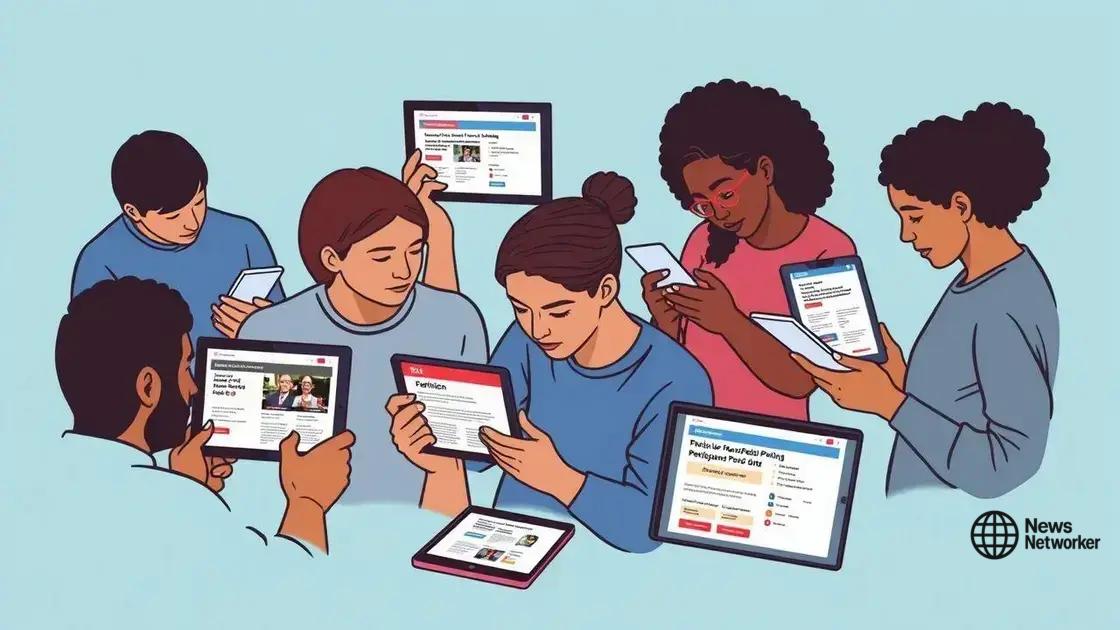Mobilization campaigns using digital petitions: A guide

Mobilization campaigns using digital petitions leverage online tools to gather support for causes, overcoming challenges like information overload and engagement by utilizing clear messaging and effective platforms.
Mobilization campaigns using digital petitions are reshaping the way we advocate for change. Have you ever signed a petition online? It’s a powerful way to voice concerns and rally support.
Understanding digital petitions and their impact
Understanding digital petitions is essential in today’s digital world. These petitions allow individuals to voice their concerns and rally support for various causes online. They have become a powerful tool for change, enabling communities to push for action from governments, organizations, and decision-makers.
Moreover, digital petitions can reach a vast audience quickly. They harness the power of social media and online networks, making sharing easier than ever. By promoting awareness about important issues, they mobilize citizens and give a voice to those who might otherwise be unheard.
What Makes Digital Petitions Effective?
Several factors contribute to the effectiveness of digital petitions. First, the ease of access allows anyone with internet access to participate. This inclusivity fosters a sense of community around shared goals. Additionally, digital petitions can be tailored to target specific audiences.
- Clear and passionate descriptions can inspire action.
- A catchy title helps grab attention.
- Engaging visuals enhance the message.
- Utilizing social media to spread awareness increases reach.
Another crucial element is timing. Engaging the public when an issue is trending can amplify the petition’s visibility. By aligning with current events or movements, petitioners can capture the public’s attention and maximize support.
The Impact of Digital Petitions
The impact of digital petitions extends beyond the signatures collected. They encourage civic engagement and empower citizens to participate in democracy actively. When people see their signatures contributing to a larger movement, it fosters a sense of ownership and responsibility.
Moreover, many successful petitions have led to tangible changes. For instance, numerous social reforms and policy changes have originated from petitions that amassed significant support. Furthermore, they can create dialogues between the public and officials, holding leaders accountable.
Through these processes, digital petitions serve as a catalyst for societal change, allowing individuals to come together and advocate for their rights and the well-being of their communities.
Steps to create an effective mobilization campaign
Steps to create an effective mobilization campaign are crucial for achieving real change. Whether you are advocating for a local cause or a global issue, following a clear process can enhance your effectiveness. The first step is to define your goals. What do you want to achieve? Clear goals help focus your efforts and communicate your message.
Next, identify your target audience. Knowing whom you want to reach ensures that your campaign is directed at the right people. Understanding the demographics, interests, and values of your audience can guide your messaging strategy.
Crafting Your Message
Once you know your audience, it’s time to craft your message. A compelling narrative can resonate deeply. Make sure to use emotion and facts to create a persuasive storyline. Highlight personal stories that relate to the cause, as these can connect with people’s hearts.
- Keep your message simple and clear.
- Use strong calls to action that motivate people to participate.
- Incorporate visuals, such as images or videos, to enhance understanding.
After establishing your message, choose the appropriate platforms for outreach. Social media channels are powerful tools for mobilization. They allow for direct interaction and sharing among supporters. You can also consider email campaigns to reach individuals directly.
Engaging Supporters
Engagement is key in any mobilization campaign. Encourage supporters to spread the word. Create shareable content, like graphics or videos, that make it easy for them. Hold online events or meetings to keep supporters informed and motivated.
As your campaign progresses, track your progress. Use analytics tools to measure engagement and reach. Understanding what works allows you to adjust your strategy as needed. Always be prepared to pivot if something isn’t resonating.
Lastly, celebrate your wins, no matter how small. Acknowledging progress encourages continued participation and keeps your community energized.
Best platforms for digital petitions

Choosing the best platforms for digital petitions is vital for the success of your campaign. With many options available, it’s essential to understand what each platform offers to find the right match for your goals. Some platforms focus on ease of use, while others emphasize outreach potential.
One popular option is Change.org. This platform is user-friendly and allows anyone to create petitions easily. Its vast network helps amplify your cause, giving it a broader reach. Additionally, Change.org provides tools for sharing petitions on social media, attracting supporters quickly.
Other Notable Platforms
Another excellent choice is Care2. This platform combines activism with social networking, allowing users to engage more with their cause. Petition creators can tap into Care2’s existing community, which is focused on social justice and environmental issues.
- PetitionSite.com is another option, providing straightforward petition creation without many extras.
- GoPetition offers great customization for your petitions, letting you tailor them to fit your audience’s needs.
- SumofUs is focused on corporate accountability, making it a perfect choice for petitions aimed at businesses.
When selecting a platform, consider the unique features each one offers. Look for options that allow for easy sharing and integration with social media. This connectivity can significantly enhance your campaign’s visibility. It’s also worthwhile to check if the platform provides analytics tools, allowing you to track engagement and signatures.
Lastly, think about your target audience. Some platforms cater to specific causes or communities. Choosing one that aligns with your audience’s interests can boost participation and success rates.
Case studies: Successful mobilization campaigns
Examining case studies of successful mobilization campaigns can provide valuable insights into what works. These campaigns often utilize strategic approaches to engage the public and drive change effectively. One notable example is the Ice Bucket Challenge. This viral campaign raised awareness and funds for ALS research. By encouraging people to share videos of themselves pouring ice water over their heads, it created a fun challenge that spread rapidly across social media.
Another significant example is the Women’s March held in January 2017. It drew millions to various cities globally, advocating for women’s rights and social justice. This campaign’s success stemmed from clear messaging, strong visuals, and a united front. It effectively used social media to mobilize supporters, showing the power of community action.
Lessons Learned from Successful Campaigns
Successful mobilization campaigns share common elements. They often start with a strong narrative that resonates deeply with potential supporters. By connecting personal stories to larger causes, these campaigns can inspire action. Effective use of digital platforms for outreach also plays a crucial role in their success.
- Clear and concise messaging that highlights the cause.
- Utilization of compelling visuals to attract attention.
- Engagement tactics, like hashtags and interactive challenges.
- Building a community around shared values and goals.
Additionally, measuring campaign effectiveness is vital. Campaigns that analyze their reach and engagement can learn what strategies are most effective. This data can guide future efforts, allowing for improvements and adjustments along the way.
By looking at these case studies, it becomes clear that mobilization campaigns can create significant change. Emphasizing genuine community involvement and strategic messaging can amplify voices and lead to tangible outcomes.
Challenges in mobilizing support online
Mobilizing support online comes with its own set of challenges. One of the biggest hurdles is information overload. With so many causes and campaigns online, it can be difficult for potential supporters to focus on a single cause. This makes it crucial for campaigns to deliver clear and engaging messages that stand out.
Another challenge is maintaining engagement. Online supporters can be easily distracted, and keeping their interest can be tough. It’s important for campaigns to provide regular updates and interactions to keep supporters motivated. Engaging storytelling can help by making the cause relatable and compelling.
Platform Limitations
Different platforms have different rules and algorithms that can limit visibility. For example, social media sites often change their algorithms, affecting who sees what. This means that a post might not reach all the followers a campaign has. Campaigns must stay updated on these changes to improve their outreach.
- Utilizing paid promotions can enhance visibility but requires a budget.
- Clever use of hashtags can help reach a broader audience.
- Engagement with followers through comments and messages strengthens community ties.
Additionally, campaigns may face difficulties in converting online support into offline actions. Mobilizing people to attend events or participate in advocacy can be challenging. To bridge this gap, clear calls to action are essential. It’s helpful to outline specific steps that supporters can take to contribute, whether by signing a petition, attending a protest, or sharing information with their networks.
Finally, the challenge of accountability comes into play. With online activism, it can sometimes feel as though involvement is less serious than in-person actions. Campaigns must reinforce the impact of online participation and show supporters that their voices genuinely matter in driving change.
The key to successful mobilization campaigns lies in understanding the challenges and leveraging effective strategies. By recognizing the hurdles, such as information overload and engagement difficulties, campaigns can adapt and grow. Utilizing the right digital platforms increases outreach while crafting compelling messages can inspire community involvement. Engaging supporters through clear calls to action is essential for turning online support into meaningful offline actions. As we move forward, let’s remain committed to uplifting our voices and making a difference through mobilization.
FAQ – Frequently Asked Questions about Mobilization Campaigns
What are digital petitions?
Digital petitions are online tools that allow individuals to voice their concerns and gather support for specific causes.
How can I effectively engage supporters online?
You can engage supporters by providing regular updates, utilizing compelling visuals, and maintaining an interactive dialogue through social media.
What platforms are best for launching a petition?
Platforms like Change.org, Care2, and GoPetition are popular choices for launching effective digital petitions and reaching wider audiences.
What challenges do mobilization campaigns face?
Challenges include information overload, maintaining engagement, and converting online support into offline action.





